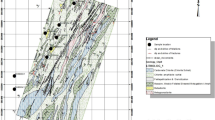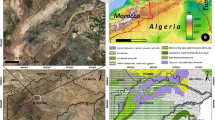Abstract
Elaborating a proper mine-planning is a crucial stage to define the success of a mining project. In the long-term it is desired to define the final pit and the mine sequencing, and this is the objective of the present paper, in which different methods were compared to get to the best viable economic result. Out of a database from a known copper deposit, two main methods were used to describe the behaviour of the mineral grade. The methods used were the Geostatistical model, using Ordinary Kriging, and the Inverse Distance Squared (IDS). Each one of them defined three pits using, respectively, Floating Cones algorithm, Lerchs-Grossmann (LG) algorithm and Direct Block Scheduling (DBS). The tests and their analysis showed that there are great variations on the results provided from each methodology. For IDS methodology, the economic difference between Floating Cone and the LG algorithm is about 62%, while the Kriging method resulted on a difference of 50%. In both cases, LG algorithm returned higher results. The comparison between scheduling methods shows that for IDS, DBS returned an economic result 17% higher than the Best Case and 23% for the Worst Case. Considering the Kriging method, the difference is about 16% higher for DBS in comparison to the Best Case and 22% for the Worst Case. All the results were obtained using specific software for each case.
Access provided by Autonomous University of Puebla. Download conference paper PDF
Similar content being viewed by others
Keywords
1 Introduction
The objective of Strategic Mine Planning is to define the final pit geometry in order to obtain the highest possible profit, improving the extraction capacity with minimum costs. The main methods used to determine the final pit are the Floating Cone technique and Lerchs-Grossmann algorithm. The first one considers physical and geomechanical characteristics, not always returning a maximum pit value. On the other hand, Lerchs-Grossmann algorithm presents an optimum pit, since it aims to maximize its financial return [1].
Once final pit is determined, it is necessary to define a production chart in long, medium and short term. This phase will be responsible for defining the sequence in which each block will be removed from the pit, considering different restrictions [1]. To obtain this scheduling some methodologies can be used, such as the traditional scheduling or Direct Block Scheduling (DBS). The traditional method is developed starting from the pit benches or the defined pushbacks, which will lead the way to mine the blocks, respecting these restrictions. DBS does not consider restrictions, determining directly which blocks will be mined and the best moment to do it.
The methods to evaluate a mine deposit are classified as follows: classic methods, statistical methods and geostatistical methods. In this paper two methodologies will be used to estimate a mine deposit: Kriging and Inverse Distance Squared (IDS). The first one is a geostatistical method that determines values in places that were not sampled using experimental data and their spatial correlation. On the other hand, IDS is a classic linear method, where the weight attributed for a sample is inversely proportional to the squared distance between the estimated point and the sample [2].
This paper is a case study about a copper mine, and it can contribute as a reference for similar cases about long-term mine planning.
2 Methods
2.1 The Deposit
The chosen mine deposit for analysis in this paper was Radomiro Tomic, which belongs to Corporación Nacional del Cobre de Chile (CODELCO). It is a copper deposit located in Chile and its main minerals are chrysocolla and atacamite. Main data of this deposit were obtained from [3] and [4].
2.2 Compositing
The composition was made based on the bench size starting from the highest elevation found among the holes. The maximum number of intervals was used for more precise results. Table 1 shows the data used to define the composites.
2.3 Variogram
The data used to elaborate the Variograms are in Table 2 and its parameters in Table 3.
The model presented good approximation to experimental points, regardless the direction being analysed. This shows that the deposit, in general, have a good spatial correlation of the grades and an isotropic behaviour.
2.4 Block Model
The block model was defined using the data on Table 4.
2.5 Kriging Estimative and Inverse Distance Square (IDS)
The parameters of Table 5 were used to find the Inverse Distance Squared (IDS) and Kriging, and the maximum search distance was defined as 200 m in both cases. For Kriging, it was necessary to apply the parameters obtained from the variograms, such as nugget, sill and range (Fig. 1).
2.6 Blocks Economic Value
The data used to evaluate the blocks are in Table 5.
To describe the economic values of each block, it was made an evaluation of the revenue and the costs associated with the extraction, becoming possible to define the economic block value. Benefit Function is defined as:
Where, R is the global recovery of the plant, T is the block grade, P is the ore price, C1 is the mine cost, Cp is the processing cost and CG&A represents general and administrative costs [5].
2.7 Floating Cone Pits
Out of the block model, the Floating Cone technique was applied and the results are shown in Fig. 2 below.
2.8 Lerchs-Grossmann Pits
To define the pits using Lerchs-Grossmann algorithm it is necessary to define the maximum value of each block using the following equation:
Where, V is the output block value, R is the recovery, G is the grade, T is the block tonnage, F is a conversion factor, rf is the revenue factor, P is the ore price, Cs is the sell cost, Cm is the mine cost and Cp is the processing cost.
The data used to calculate these values are basically the ones in Table 5, with some additional parameters shown in Table 6.
The block tonnage is calculated by the multiplication of the block dimensions and its density, and the revenue factor ranges from 0 to 1 using a step of 0.2 (Figs. 3 and 4).
2.9 Traditional Scheduling
The traditional scheduling was made for the Worst and the Best Case scenarios. In both cases, it is necessary to define the maximum production capacity of the mine, which is about 30.000.000 tons per year. In the Worst Case, the scheduling is based on mining each bench in sequence, so the revenue factor used was 1 to include all the pit blocks. On the other hand, the Best Case uses the pushbacks to develop the scheduling, so it was necessary to include all the defined revenue factors, so all the nested pits were included (Figs. 5 and 6).
2.10 Direct Block Scheduling
DBS was processed using the data obtained from the application of the Lerchs-Grossmann algorithm. Most of the parameters used to run the DBS were defined before, such as tonnage, prices and costs, annual production and nested pits. The discount rate equals 0.1 (Figs. 7 and 8).
3 Results and Discussion
After defining the final pits for each method, economic analyses were performed. The results are shown in the following Table 7.
Lerchs-Grossmann is economically better than the Floating Cone technique, which is explained by the fact that the algorithm is an optimizer, while the Floating Cone technique does not always return an optimum final pit. Comparing the estimation methods, it is possible to notice that IDS returned higher values. Considering that Kriging is a more assertive method, it is believed that IDS overestimated the deposit.
After the scheduling process it was possible to compare the Net Present Values (NPVs) of each situation. The traditional scheduling returned a life of 28 years for the IDS method and 23 years for Kriging, while DBS defined a horizon time of 24 years for IDS and 20 years for Kriging. The Table 8 shows the NPVs for the estimation methods used.
As it is noticed from Table 8, DBS returns the best economic result, which is justified because this method progressively takes the higher value blocks, mining a great volume of ore in the first years with minimum waste being extracted, while the final years present an opposite situation. The Best and the Worst Cases have a variable production of ore and waste along the years, not selecting a block based on its value, but in pushbacks and benches, respectively.
4 Conclusion
The comparison between the estimation methods showed that Kriging returns more assertive results than IDS method. That could be explained because Kriging considers the spatial correlation between the samples. Analysing the obtained results, it is believed that IDS overestimated the mineral reserve, which could be seen from the bigger size of the pits calculated by this method. In both methods to define the final pit, IDS returned higher economic values.
Lerchs-Grossmann algorithm presented better financial results than the Floating Cone technique, with a significant difference: for IDS, the results were 62% higher and, for Kriging, 50% higher. That happens because the algorithm is an optimizer, which means it always chases the best economic solutions for the project.
The best scheduling chart was obtained from DBS, since it aims to optimize the block mining without considering a geometric restriction. Traditional scheduling presented good results in both Best and Worst Cases and, besides there were some differences in the NPVs obtained by these two methods, they were not as relevant when compared to DBS method. For the IDS method, the difference was about 17% higher for DBS in comparison to the Best Case and 23% to the Worst Case. Considering the Kriging method, this difference was, respectively, 16% and 22%.
References
Flores, B.A.: Planejamento de Lavra Estratégico e Tático de Morro da Mina - Conselheiro Lafaiete/MG. 2008. 150 f. Dissertação de Pós-Graduação em Engenharia Mineral. Departamento de Engenharia de Minas. Universidade Federal de Ouro Preto, Ouro Preto
Curi, A.: Minas a Céu Aberto: Planejamento de Lavra. Oficina de textos, São Paulo (2014)
Codelco. Divísion Radomiro Tomic. Operaciones. https://www.codelco.com/division-radomiro-tomic/prontus_codelco/2016-02-25/163906.html. Accessed 23 Mar 2019
Hustrulid, W., Kuchta, M., Martin, R.: Open Pit Mine Planning & Design, vol. 2, 3rd edn. CRC Press/Balkema, Leiden (2013)
Peroni, R.: Planejamento de Lavra a Céu Aberto. Curso de Lavra a Céu Aberto, 29 p. Departamento de Engenharia de Minas, Universidade Federal do Rio Grande do Sul, Porto Alegre (2007)
Author information
Authors and Affiliations
Corresponding author
Editor information
Editors and Affiliations
Rights and permissions
Copyright information
© 2020 Springer Nature Switzerland AG
About this paper
Cite this paper
Moreira, A.L.M., da Silva Campos, B.I., Campos, P.H.A., da Silva Borges Barbosa, V., Casagrande, P.B. (2020). Comparison of Methods to Define the Final Pit - A Case Study. In: Topal, E. (eds) Proceedings of the 28th International Symposium on Mine Planning and Equipment Selection - MPES 2019. MPES 2019. Springer Series in Geomechanics and Geoengineering. Springer, Cham. https://doi.org/10.1007/978-3-030-33954-8_14
Download citation
DOI: https://doi.org/10.1007/978-3-030-33954-8_14
Published:
Publisher Name: Springer, Cham
Print ISBN: 978-3-030-33953-1
Online ISBN: 978-3-030-33954-8
eBook Packages: EngineeringEngineering (R0)












